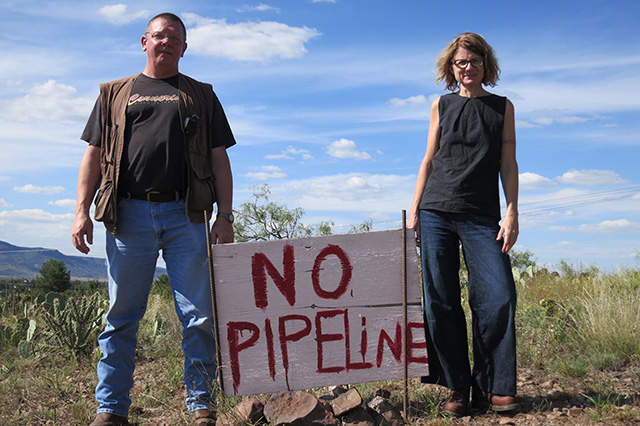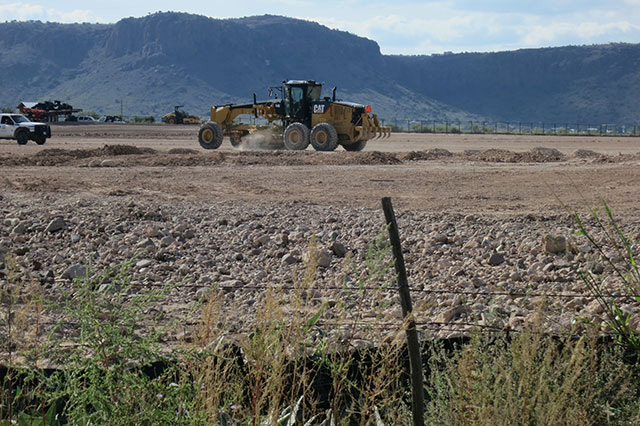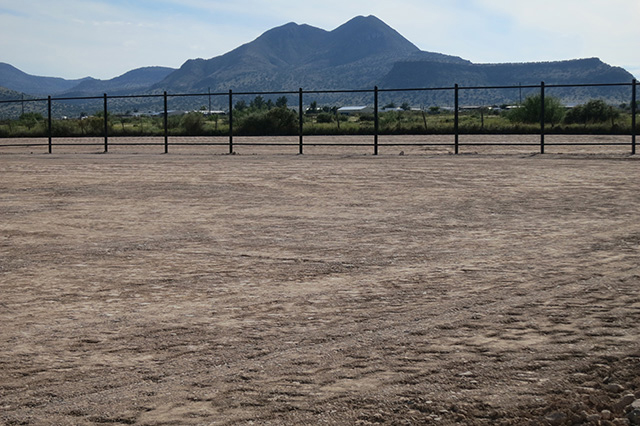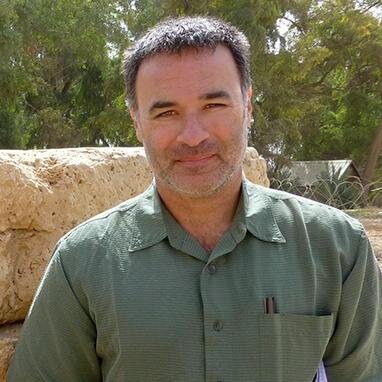This post originally appeared at Truthout

Coyne Gibson and Alyce Santoro are part of a grassroots resistance movement opposing a massive gas pipeline project between Mexico and the US. (Photo: Dahr Jamail)
If a couple of billionaires get their way, a 143-mile-long, 42-inch high-pressure natural gas transmission pipeline will be built right through the heart of Texas’ starkly beautiful and remote Chihuahuan desert. Plans are currently in the works for the pipeline, which would be larger in diameter than the infamous Keystone XL.
Although it has garnered far less media attention than the Keystone XL, this West Texas project has already sparked a massive grassroots resistance movement that has unified ranchers, Tea-Partiers, artists, environmentalists and the vast majority of the residents in this sparsely populated corner of the country.
Texas billionaire Kelcy Warren, the head of the Dallas pipeline company Energy Transfer Partners (ETP) which now boasts former Texas governor Rick Perry on its board of directors and Carlos Slim of Mexico, who is reportedly the second-richest person on earth, are the core partners behind the Trans-Pecos pipeline project. The aim of the pipeline is to deliver natural gas from Texas to Mexico, where it is in high demand.
Transporting gas from a plant in Coyanosa, near Fort Stockton, Texas, down to the border, the line is supposed to be built underneath the Rio Grande River, after which it will connect into Mexico’s gas infrastructure.
Slim and Warren promise that the pipeline will be both safe and environmentally friendly.
“I used to do this kind of work, so I admit to past crimes, so to speak,” Gibson told Truthout in Alpine, Texas, where signs of the pipeline’s construction are already evident.
“I’ve seen firsthand what this [pipeline] does to the places it touches,” he said. “It is horrifically environmentally impactful. The immediate impact is the absolute environmental destruction of every living thing in its path. And that’s just to get started.”
It is information like this coming from Gibson, coupled with what people are perceiving as an arrogant and bellicose attitude of Energy Transfer, that has created what has now become a battle for the land in Far West Texas.
“It Tends to Be Catastrophic”
Gibson is now a research engineer for one of the nation’s premier observatories, where he takes care of the massive telescopes.
Despite the fact that every time he speaks out he states very clearly that he is speaking as an individual and does not, in any way, represent his employer or institution, his job has come under threat on multiple occasions. He knows several others, including a National Park Service employee who opposes the pipeline, who have experienced similar attacks.
Speaking out against the pipeline in a state as oil-happy as Texas, Gibson has taken several shots but weathered them all because his facts and his extensive experience in the industry are unarguable.
Having worked for the Houston division of Fluor Engineering as an electrical and control systems engineer, his experience in the oil and gas industry included a variety of petrochemical infrastructure projects, including systems associated with oil, natural gas and natural gas liquids; gas processing facilities; refineries; and transportation and distribution systems, including pipelines and associated compressor stations.
Thus, Gibson is as informed as anyone about what can go wrong with highly pressurized gas pipelines.
For example, he points out that after companies have installed a pipeline underground, they then try to cover up and “restore” the construction damage, but this is not possible.
“That process is maybe, at best, marginally successful over a long time period,” Gibson said. “But out here, in this fragile ecosystem, there is little chance for restoration.”

Gibson, who has decades of experience working in the oil and gas industry, warned of long-term environmental damage from pipeline construction and maintenance. (Photo: Dahr Jamail)
Maintenance on high-pressure gas pipelines is also a risky endeavour. “For them then to do maintenance on the pipeline, they have to shut off sections and then open up a valve and vent natural gas straight into the air,” he explained. “For a high-pressure transmission system, that is like standing next to jet aircraft running full bore. Then from four to seven hours later it stops, they do the work, close it back up and it goes back online. That would happen regularly.” The noise of this alone makes being anywhere near it, let alone living anywhere near it, untenable as well as dangerous to one’s health.
Gibson also has prior experience at Hudson Engineering, another petrochemical and construction firm, working in the field. His duties included start-up and shutdown field inspections, troubleshooting and working on natural gas projects, including the gas-processing plants, interconnect facilities and compressor stations, most of which will be included in the Trans-Pecos pipeline project.
Having constructed them in the past, Gibson issued a stark warning for people who may live near one of the pipeline’s compressor stations.
“Whoever lives near that is in for loads of joy,” he warned. “Demand on a pipeline changes, so they would sometimes depressurize the line, venting methane into the atmosphere, which is called a compressor station blowdown.”
Here’s someone recording over 90dB of noise of one of these compressor stations in a YouTube video, to give you an idea. That is the noise equivalent of standing 50 feet from a jackhammer or standing near large truck traffic.
On top of these impacts, there is a massive environmental concern: the well-known deleterious impact of methane in the atmosphere. Methane is 86 times more potent a greenhouse gas than CO2 over a 20 year time scale.
However, the depressurization and noise may be the least of residents’ worries, compared to what else can go wrong.
“It’s likely there will be an explosion – not if, but when,” Gibson stated flatly. “At a random place along the line, the risk, let’s say, is X. At a compressor station the risk is 10X or greater, because it has people working on it, rotating machinery, electrical systems and vehicular traffic; concomitant risk is there. And when something goes wrong, it tends to be catastrophic.”
Fire Risks
Gibson is one of less than 100 volunteer fire-fighters in the three counties where the pipeline is slated to be built.
He is well acquainted with what the capabilities of the rescue teams are, has deep knowledge of the fire risk of the pressurized gas pipeline and sees it as “something that is just not appropriate for this region.”
A spark in the town of Marfa, one municipality in the region, ignited the Rock House Fire in 2011, which burned over 314,000 acres in 30 days.
“So imagine a high pressure gas pipeline ruptures and a fire starts and we can’t even approach the line and we have no surface water to fight it,” Gibson said. “We would have insufficient apparatus, we couldn’t put enough water on it, we might as well stand there and spit on it.”
The proposed pipeline route passes within 1.1 miles of Big Bend Regional Medical Center, which is the only hospital that exists in the entire region.
Moreover, the center is only a 24-bed hospital and does not even have a trauma center.
“The pipeline also passes within 400 yards of the Alpine airport, which is the only medevac facility in the region,” Gibson said.
These issues, among many, many others, leave Gibson shaking his head when asked about the general idea of the pipeline in the region.
“It’s just nuts,” he said. “If people across the US knew what was going on at many levels, private property, safety, etc., they would be outraged.”
Laying the Groundwork for Fracking?
In his battle to stop the pipeline, Gibson has joined forces with Alyce Santoro, an artist who lives in the nearby Davis Mountains with her husband. Santoro, who along with other residents learned of the pipeline project in spring 2014 and quickly began working to inform people of their findings.
The more she learned, the more alarmed she became, as she believes one role of the pipeline is to lay down the infrastructure necessary in order to bring fracking to the pristine Big Bend region.
“The Woodford shale in Presidio and Brewster counties will be the subject of future exploration,” Santoro said. “There are many signs that it can be an economically viable source of natural gas. It has depth, thermal maturity and high organic content. These three are what geologists look for when exploring for shale gas.”
One drawback to drilling for oil and gas in the Big Bend region of West Texas is the lack of water. New wells require water to drill and millions of gallons of water for hydraulic fracturing of the shale once the well is completed. Waters is as scarce as hen’s teeth in this part of the nation.
“The only reason fracking hasn’t come here already is because the infrastructure isn’t here,” Santoro told Truthout. “But this pipeline is a key component of that infrastructure.”
Santoro and other local residents formed the Big Bend Conservation Alliance (BBCA) in 2014. At one of group’s community meetings she met Gibson and they co-founded Defend Big Bend, a loosely organized group of community members interested in initiating and participating in what she describes as “creative direct action.”
The work of these groups corresponds to a broader movement that is growing across Texas against fracking, pipelines and other nefarious actions of the oil and gas industry in the state – a state whose regulations are, in practice, largely non-existent.
When the BBCA learned that the city representatives in Alpine were not even aware of the proposed pipeline, despite the fact it would have a dramatic impact on their town, the group organized a large public meeting last spring. It was widely attended. “We had ranchers, teachers, artists, even people who work in the oil and gas industry, Border Patrol, people from all parts of the community, everyone came,” Santoro said.
People from across the political spectrum attended. At the meeting, Gibson started providing accurate information about what the nascent anti-pipeline group was up against. The facts are of the utmost importance, says Santoro: She believes that if people are provided with the right information, they will do what is best for the land.
Shortly after the BBCA’s first community meeting, ETP called an open house meeting of its own.
“At that meeting I asked one of the ETP representatives what the blast radius would be if a 42″ pipeline at the expected pressure exploded,” She said. “The rep said he didn’t know what that meant. I was directed to another representative who told me that the dangers were practically nil. He tried to discount my question by saying, ‘You know airplanes crash, right? Yet you still fly on them.'”
Both she and Gibson are impacted deeply by the landscape in which they live and they have the impression that most people who live in the region feel similarly.
“People here have an incredible sense of place,” Santoro said. “Our consciousness is woven into the landscape. We experience these vistas daily and can’t help but be moved by them.”

Most residents of the Big Bend region cherish the wide-open natural vistas, and worry the pipeline project will inevitably tarnish the landscape. (Photo: Dahr Jamail)
This is at least part of the reason why, according to Santoro, most people in the area are strongly opposed to the pipeline.
“There is hardly anyone in favor of the pipeline,” she said. “People who want this here don’t write letters to the editor, they don’t come to meetings to state their case. I’ve seen maybe three pro-pipeline yard signs in town, compared to over 100 anti-pipeline signs in people’s yards or businesses.”
Gibson pointed out that out of all the comments submitted to the Federal Energy Regulatory Commission (FERC) about the pipeline, only six out of the 615 comments were in support of the project.
Economic Benefit?
Those who are in favor of the pipeline, according to both Santoro and Gibson, are generally people who believe they will benefit economically from it.
“But there hasn’t been any evidence to back this up,” Santoro said. “I’ve yet to find someone in favor of it who has solid evidence to back up their support.”
The residents of the small town of Presidio, which does not currently have access to natural gas, have been led to believe they will get it if the pipeline goes through.
Santoro pointed out that the local media has failed to follow up on this, which has likely perpetuated the myth that residents will somehow benefit from the pipeline.
“Local media is completely dropping the ball by allowing residents of Presidio to continue to believe they are getting natural gas from this,” she said. “Nobody has heard Energy Transfer or any of the other players offer assurances that they are going to deliver gas to Presidio, let alone get the appliances they’d need to have it [natural gas]. For one thing, this would require the involvement of a municipal gas company. Has one been established? Who will pay for the many miles of necessary infrastructure? What would be the cost of the gas to local residents? Who will help the community acquire or convert to natural gas-fired appliances?”
Gibson even submitted a Freedom of Information Act request to the FERC about the possibility of Energy Transfer supplying natural gas to Presidio. The FERC responded with the information, but then retracted it eight hours later at the request of Energy Transfer; the company claimed the information’s release would harm it economically.
However, even the information that the company has disclosed should dispel any myth that Presidio would get natural gas if the pipeline project goes through.
“The company [Energy Transfer] has disclosed that there is no relationship to a distribution company,” he said. “So to supply gas to Presidio, they need a private investor owned company or another mechanism to supply that gas to Presidio, which the company inadvertently disclosed that in a recent document. They supplied that information themselves. Hence, they’ve never said that they would [supply gas to Presidio].”
Gibson describes Energy Transfer’s behaviour as “the sin of omission.” Santoro added, “The company just never discloses the truth.”
Some people believed that Energy Transfer would pay them handsomely for selling the requisite land for the project to the company. Instead, the company is using eminent domain to take land from unwilling sellers, which has infuriated most landowners. According to the eminent domain law in Texas, if a company fails to reach an agreement with a landowner and the landowner refuses to sell, the company can “condemn” the land needed for the pipeline. Fighting a company’s claim of eminent domain in court can be both expensive and very time consuming and all a company needs to do in order to get eminent domain is check a box on a two-page form to the Railroad Commission of Texas. The checked box then states the pipeline company is a “common carrier,” and thus it is in the public interest.
Plus, according to Gibson, Energy Transfer’s initial offer to landowners in the region is $5.00 range per linear foot, but that price gives the company the right to place as many pipes in the area as they please – based on how the easement is negotiated with a landowner. A landowner who isn’t necessarily savvy about the business and legal issues may not realize that the number of pipelines allowed to cross is negotiable in the terms.
“But the linear foot pricing is normally computed as the pipeline diameter times two,” Gibson explained. “So in this case it should be $84 per linear foot, but Energy Transfer thinks people out here are backwoods hicks … and that people won’t lawyer up or know where to look.” And so, the company plans to pay the lowest possible amount, thinking it will get away with it.
In addition to this insult, Energy Transfer, according to Gibson, is only offering its price as a one-time payment.
“Some people think they will be paid annually for the amount of gas transported through the line and the company does nothing to give them reason to believe otherwise,” Gibson added.
On the other side of the border in Mexico, the pipeline companies are being less discreet.
Gibson pointed toward another economic issue that left him concerned about the project: He sees it as a means of manipulating the gas market.
“The US is a net importer of natural gas. Why, if we are a net importer, why would I want to export a single cubic foot of natural gas? I can tell you why. If you look at how it’s produced, via fracking, the US is not only a net importer, but it’s the highest costing gas in the world. The folks who produce have to get $3 per million cubic feet and that is the break-even cost. The market price in the US is $1.50 on average per million cubic feet, so the reason to export Shale gas is to drive the price up above that $3 per million cubic feet so you can make money on it. So it’s market manipulation. At $1.50 per million cubic feet you should leave it in the ground.”
In 2014 in the Permian basin alone, gas companies flared 62 million cubic feet of natural gas every single day, simply burning it off into the atmosphere. In the greater US, that number was 603 billion cubic feet flared off into the atmosphere, daily, according to the US Energy Information Administration.
The Trans-Pecos pipeline, by comparison, would only export 1.4 billion cubic feet per day and there is no domestic consumer for its gas whatsoever.
“If I’m importing and flaring natural gas at that rate, why would I export a single cubic foot of it anywhere else?” Gibson asked, giving credence to the possibility of market manipulation.
The Fight of the Present – and the Future
Neither Santoro nor Gibson want to take any personal credit for their work in educating the public about the pipeline. “This is not me, this is not Alyce, this is a 100 percent citizen-led effort here,” Gibson said. “We are just here helping point things out.”
Santoro agreed.
“This has been an incredible community-led effort. People see what needs doing and do it, from fundraising to letter-writing campaigns to street-side protests,” she said. “My job is simply sharing information. When people have access to the facts, they are outraged.”
Both of them are heartened by the reactions of people across the region.
“The level of awareness of our region is great,” Gibson said. “How pristine and important and rare it is. People have gone out and seen what this thing would run over and kill or what would change in their vista … It’s now documented, you can read these comments and you see a combination of intellect and passion aimed at a federal agency, articulating, ‘Here is what is at risk.'”
The FERC is expected to release information about the project this coming January or February, as the agencies’ environmental assessment scoping period ended in September. Energy Transfer’s own documents, which it submitted to the FERC, according to Gibson, admitted that no domestic customer exists for its gas.
The FERC will nonetheless evaluate Energy Transfer’s responses to their requests and eventually the FERC will have to issue a finding of “no significant impact” if the permits for the pipeline are to move forward. Alternatively, other possibilities are that Energy Transfer must conduct a more in-depth environmental assessment or environmental impact statement.
As for Santoro, she intends to continue fighting the pipeline and other projects like it, no matter how long it takes.
“I have been calling out the misdeeds of the fossil fuel industry and singing the praises of alternatives since long before this issue came to my back yard. Frankly, I never thought the day would come when we would have to fight this here in the Big Bend. But now it’s here, it gives me the opportunity to take what I’ve learned through participation in the broader social ecology movement and put these skills to work within my own community,” she said.
Santoro has high hopes for how her community’s work in opposing the pipeline will contribute to the national fight to end the larger fossil fuel industry.
“This insanity needs to end,” she concluded. “The fossil fuel industry needs to be stopped everywhere. When people realize the amount of harm it is causing and that there are practical alternatives, rapid change can occur.”
Gibson concurred, noting that whatever happens in Texas, word will travel.
“If we manage to defeat this thing, it’s chilling for the companies across the US,” Gibson stated. “So there’s a lot at stake.”


